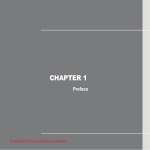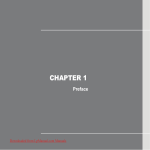Download MSI CX705MX User Guide Manual - Downloaded from LpManual
Transcript
CHAPTER 1
Preface
Downloaded from LpManual.com Manuals
1-2
Preface
Table of Content
Preface
Table of Content ............................................................................................................................ 1-2
Regulations Information............................................................................................................... 1-5
FCC-B Radio Frequency Interference Statement .................................................................... 1-5
FCC Conditions ........................................................................................................................ 1-6
CE Conformity .......................................................................................................................... 1-6
Safety Instructions........................................................................................................................ 1-7
Safety Guideline for Using Lithium Battery ..............................................................................1-11
WEEE Statement ......................................................................................................................... 1-15
Optical Device Drive Notice ....................................................................................................... 1-22
Trademarks .................................................................................................................................. 1-22
Reversion History ....................................................................................................................... 1-22
Introductions
Manual Map ................................................................................................................................... 2-2
Unpacking...................................................................................................................................... 2-3
Specification.................................................................................................................................. 2-4
Product Overview ......................................................................................................................... 2-8
Top-Open View ......................................................................................................................... 2-8
Front Side View ...................................................................................................................... 2-12
Downloaded from LpManual.com Manuals
1-3
Preface
Right Side View ...................................................................................................................... 2-15
Left Side View......................................................................................................................... 2-17
Rear Side View....................................................................................................................... 2-18
Bottom Side View ................................................................................................................... 2-20
Getting Started
Power Management ...................................................................................................................... 3-2
Connecting the AC Power ........................................................................................................ 3-2
Using the Battery Power........................................................................................................... 3-4
ECO Engine -- Power Saving Function .................................................................................. 3-10
Power Management in Windows OS ..................................................................................... 3-12
Energy Saving Tips................................................................................................................. 3-14
Basic Operations ........................................................................................................................ 3-15
Safety and Comfort Tips......................................................................................................... 3-15
Having a Good Work Habit..................................................................................................... 3-16
Knowing the Keyboard ........................................................................................................... 3-17
Knowing the Touchpad ........................................................................................................... 3-24
About Hard Disk Drive............................................................................................................ 3-27
Using the Optical Storage Device........................................................................................... 3-28
Connecting the External Devices.............................................................................................. 3-31
Connecting the Peripheral Devices ........................................................................................ 3-31
Connecting the Communication Devices ............................................................................... 3-34
Downloaded from LpManual.com Manuals
1-4
Preface
ExpressCard Installation............................................................................................................ 3-37
Removing the ExpressCard ................................................................................................... 3-37
Installing the ExpressCard ..................................................................................................... 3-37
Components Replacement and Upgrade ................................................................................. 3-39
BIOS Setup
About BIOS Setup......................................................................................................................... 4-2
When to Use BIOS Setup......................................................................................................... 4-2
How to Run BIOS Setup........................................................................................................... 4-2
Control Keys ............................................................................................................................. 4-3
BIOS Setup Menu.......................................................................................................................... 4-4
Main menu................................................................................................................................ 4-5
Advanced menu........................................................................................................................ 4-7
Security menu........................................................................................................................... 4-8
Boot menu .............................................................................................................................. 4-10
Exit menu.................................................................................................................................4-11
Downloaded from LpManual.com Manuals
1-5
Preface
Regulations Information
FCC-B Radio Frequency Interference Statement
This equipment has been tested and found to comply with the limits for a Class B digital device,
pursuant to part 15 of the FCC rules. These limits are designed to provide reasonable protection
against harmful interference in a residential installation.
This equipment generates, uses and
radiates radio frequency energy, and, if not installed and used in accordance with the instructions,
may cause harmful interference to radio communications. However, there is no guarantee that
interference will not occur in a particular installation.
If this equipment does cause harmful
interference to radio or television reception, which can be determined by turning the equipment off
and on, the user is encouraged to try to correct the interference by one or more of the following
measures:
Reorient or relocate the receiving antenna.
Increase the separation between the equipment and receiver.
Connect the equipment into an outlet on a circuit different from that to which the receiver is
connected.
Consult the dealer or an experienced radio TV technician for help.
NOTE
The changes or modifications not expressly approved by the party responsible for
compliance could void the user’s authority to operate the equipment.
Downloaded from LpManual.com Manuals
1-6
Preface
Shield interface cables and AC power cord, if any, must be used in order to comply with the
emission limits.
FCC Conditions
This device complies with part 15 of the FCC Rules. Operation is subject to the following two
conditions:
This device may not cause harmful interference.
This device must accept any interference received, including interference that may cause
undesired operation.
CE Conformity
This device is in compliance with the essential safety requirements and other relevant
provisions set out in the European Directive.
Downloaded from LpManual.com Manuals
1-7
Preface
Safety Instructions
Read the safety instructions carefully and thoroughly.
All cautions and warnings on the equipment or user’s manual should be noted.
Keep the User’s Guide that comes with the package for future reference.
Keep this equipment away from humidity and high temperature.
Lay this equipment on a stable surface before setting it up.
The openings on the enclosure are used for air convection and to prevent the
equipment from overheating. Do not cover the openings.
Do not leave the equipment in an unconditioned environment with a storage
temperature above 60OC (140OF) or below 0OC (32OF), which may damage the
equipment.
Downloaded from LpManual.com Manuals
1-8
Preface
Make sure the power voltage is within safety range and has been adjusted
properly to the value of 100~240V before connecting the equipment to the
power outlet.
Always unplug the AC power cord before installing any add-on card or module
to the equipment.
Always disconnect the AC power cord or uninstall the battery pack or switch off
the wall socket if the equipment would be left unused for a certain time to
achieve zero energy consumption.
Never pour liquid into the opening that could damage the equipment or cause an
electrical shock.
Place the power cord in a way that people are unlikely to step on it. Do not place
anything on top of the power cord.
Always keep the strong magnetic or electrical objects away from the equipment.
Downloaded from LpManual.com Manuals
1-9
Preface
When installing the coaxial cable to the TV Tuner, it is necessary to ensure that the
metal shield is reliable connected to protective earthing system of the building.
Cable distribution system should be grounded (earthed) in accordance with
ANSI/NFPA 70, the National Electrical Code (NEC), in particular Section 820.93,
Grounding of Outer Conductive Shield of a Coaxial Cable.
To prevent explosion caused by improper battery replacement, use the same or
equivalent type of battery recommended by the manufacturer only.
Always keep the battery in a safe place.
If any of the following situations arises, get the equipment checked by a service
personnel:
The power cord or plug is damaged.
Liquid has penetrated into the equipment.
The equipment has been exposed to moisture.
The equipment has not worked well or you can not get it work according to
User’s Manual.
The equipment was dropped and damaged.
The equipment has obvious signs of breakage.
Downloaded from LpManual.com Manuals
1-10
Preface
Green Product Features
Reduced energy consumption during use and stand-by
Limited use of substances harmful to the environment and health
Easily dismantled and recycled
Reduced use of natural resources by encouraging recycling
Extended product lifetime through easy upgrades
Reduced solid waste production through take-back policy
Environmental Policy
The product has been designed to enable proper reuse of parts and recycling
and should not be thrown away
Users should contact the local authorized point of collection for recycling and
disposing of their end-of-life products.
Downloaded from LpManual.com Manuals
1-11
Preface
Safety Guideline for Using Lithium Battery
(English) CAUTION: Danger of explosion if battery is incorrectly replaced.
recommended by the equipment manufacturer.
Replace only with the same or equivalent type
Discard used batteries according to manufacturer’s instructions.
(French) (Français) ATTENTION: II y a danger d’explosion s’il y a remplacement incorrect de la batterie.
uniquement avec une batterie du meme type ou d’un type équivalent recommandé par le constructeur.
Remplacer
Mettre au rebut
les batteries usages conformément aux instructions du fabricant.
(German) (Deutsch) VORSICHT: Explosionsgefahr bei unsachgemäßem Austausch der Batterie.
denselben oder einen vom Hersteller empfohlenen gleich-wertigen Typ.
Ersatz nur durch
Entsorgung gebrauchter Batterien nach
Angaben des Herstellers.
(Spanish) (Español) PRECAUCIÓN: Peligro de explosión si la batería es reemplazada incorrectamente. Cámbiela solo
por la misma o un tipo equivalente recomendado por el fabricante. Descarte usar baterías usadas de acuerdo con las
instrucciones del fabricante.
(Italian) (Italiano) ATTENZIONE: Pericolo di esplosione della batteria se sostituita in modo non corretto. Sostituire solo
con la stesso tipo o con uno equivalente come indicato nel manuale del produttore. Smaltire le batterie usate come da
istruzioni del produttore.
(Russian) (Русский) Внимание: Существует опасность взрыва батареи в случае неправильной замены. Для
замены всегда используйте такую же или эквивалентную, рекомендованную производителем оборудования.
Следуйте инструкциям производителя при утилизации использованных батарей.
(Turkish) (Türkçe) UYARI: Pil yanlıs yerleştirilirse patlayabilir. Aynı ya da muadili bir pille degistiriniz. Kullanılmış pilleri
Downloaded from LpManual.com Manuals
1-12
Preface
üreticinin talimatlarına göre degerlendiriniz.
(Greek) (Ελληνικά) ΠΡΟΣΟΧΗ: Κίνδυνος έκρηξης εάν η μπαταρία τοποθετηθεί λανθασμένα. Να αντικαθιστάτε μόνο με
τον ίδιο ή αντίστοιχο τύπο με αυτό που συνιστά ο κατασκευαστής του εξοπλισμού. Να απορρίπτετε τις χρησιμοποιημένες
μπαταρίες ως απορρίμματα σύμφωνα με τις οδηγίες του κατασκευαστή.
(Polish) (Polski) OSTRZEŻENIE: Nieprawidłowa wymiana może spowodować eksplozję baterii. Zamianę można wykonać
wyłącznie na baterię tego samego lub równoważnego typu zalecaną przez producenta urządzenia. Zużyte baterie można
wyrzucać zgodnie z instrukcjami producenta.
(Hungarian) (Magyar) VIGYÁZAT: A nem megfelelő akkumul tor haszn lata robban svesz lyes. Kizárólag ugyanolyan,
vagy a berendezés gyártója által ajánlott, egyenértékű típust használjon. Az elhasznált akkumulátorokat a gyártó
utasításának megfelelően ártalmatlanítsák.
(Czech) (Čeština) UPOZORNĚNÍ: Nebezpečí výbuchu při chybné výměně baterie.
ekvivalentním typem doporučeným výrobcem zařízení.
Nahraďte pouze stejným nebo
Použité baterie zlikvidujte podle pokynů výrobce
(Traditional Chinese ) (繁體中文) 注意: 若電池未正確更換,可能會爆炸。請用原廠建議之同款或同等級的電池來更換。
請依原廠指示處理廢棄電池。
(Simplified Chinese ) (简体中文) 注意: 若电池未正确更换,可能会爆炸。请用原厂建议之同款或同等级的电池来更换。请
依原厂指示处理废弃电池。
(Japanese) (日本語) 警告:バッテリーの取り扱いを誤ると、液漏れや破裂などにより生命や財産に重大な影響を及ぼす
恐れがあります。指定された型番以外のバッテリーは使用しないでください。バッテリーを廃棄する場合は、各自治体
の規則に従って適切に処理して下さい。
(Korean) (한국어) 주의: 배터리를 올바로 교체하지 않으면 폭발할 위험이 있습니다. 타입이 장치 제조업체에서
Downloaded from LpManual.com Manuals
1-13
Preface
권장하는
것과
동일하거나
동등한
배터리로만
교체하십시오.
사용한
배터리는
제조업체의
지침에
따라
폐기하십시오.
(Vietnamese) (Tieng Viet) LƯU Ý: Thay thế pin không tương thích có thể dẫn đến nguy cơ bị nổ. Chỉ thay thế bằng pin
cùng loại hoặc loại tương ứng khuyên dùng bởi nhà sản xuất thiết bị. Vứt bỏ pin đã sử dụng theo hướng dẫn của nhà sản
xuất.
(Thai) (ไ ท ย ) ขอควรระวัง: ถาใสแบตเตอรี่อยางไมถูกตอง อาจมีอันตรายจากการระเบิดขึ้นได
หรือเทียบเทา ที่แนะนําโดยผูผลิตอุปกรณเทานั้น
ใชเฉพาะแบตเตอรี่ชนิดเดียวกัน
ทิ้งแบตเตอรี่ที่ใชแลวตามคําแนะนําของผูผลิต
(Indonesian) (Bahasa Indonesia) PERHATIAN: Bahaya ledakan dapat terjadi jika salah memasang baterai.
baterai hanya dengan jenis yang sama atau setara sesuai rekomendasi pabrik peralatan tersebut.
Ganti
Buang baterai bekas
sesuai petunjuk pabrik
(Serbian) (Srpski) OPREZ: Ukoliko baterija nije ispravno postavljena, postoji opasnost od eksplozije. Zamenu izvršite
koristeći isključivo istu ili ekvivalentnu bateriju koju preporučuje proizvođač opreme. Odbacite iskorišćene baterije u
skladu sa uputstvima proizvođača.
(Netherlands) (Nederlands) LET OP: Er is explosiegevaar als de batterij niet goed geplaatst wordt. Uitsluitend te
vervangen door een batterij van hetzelfde of een gelijkwaardig type,zoals aanbevolen door de fabrikant. Gooi batterijen
weg volgens de plaatselijke instructies.
(Romanian) (Română) ATENŢIE: Pericol de explozie dacă bateria este înlocuită incorect. Înlocuiţi doar cu acelaşi tip sau
echivalent recomandat de fabricantul echipamentului. Evacuaţi bateriile folosite conform instrucţiunilor fabricantului.
(Portuguese) (Português) ADVERTÊNCIA:
Perigo de explosão se a bateria é substituída incorrectamente. Substitua
somente com o mesmo tipo ou equivalente recomendado por o fabricante do seu equipamento. Descarte as baterias
Downloaded from LpManual.com Manuals
1-14
Preface
utilizadas de acordo com as instruções do fabricante.
(Swedish) (Svenska) VARNING: Explosionsfara vid felaktigt batteribyte.
typ som rekommenderas av apparattillverkaren.
Använd samma batterityp eller en ekvivalent
Kassera använt batteri enligt fabrikantens instruction.
(Finnish) (Suomi) VAROITUS: Paristo voi räjähtää, jos se on virheellisesti asennettu.
valmistajan suosittelemaan tyyppiin.
Vaihda paristo ainoastaan
Hävitä käytetty paristo valmistajan ohjeiden mukaisesti.
(Slovak) (Slovenčina) UPOZORNENIE: V prípade nesprávnej výmeny batérie existuje nebezpečenstvo výbuchu.
Vymeňte iba za rovnakú batériu alebo za rovnocenný typ batérie, ktorý odporúča výrobca zariadenia. Batérie zneškodnite
podľa pokynov výrobcu.
(Slovenian) (Slovenščina) POZOR: V primeru nepravilne zamenjave baterije obstaja nevarnost njene eksplozije.
Baterijo zamenjajte le z enako ali ekvivalentno vrsto, ki jo priporoča proizvajalec.
Odpadne baterije odstranite skladno z
navodili proizvajalca.
(Danish) (Dansk) ADVARSEL!
batteri af same fabrikat og type.
Lithiumbatteri --- Eksplosionsfare ved fejlagtig håndtering.
Udskiftning må kun ske med
Levé det brugte batteri tilbage til leverandøren.
(Norwegian) (Norsk) ADVARSEL: Eksplosjonsfare ved feilaktig skifte av batteri.
tilsvarende type anbefalt av apparatfabrikanten.
Benytt same batteritype eller en
Brukte batterier kasseres I henhold til fabrikantens instruksjoner.
(Bulgarian) (български) ВНИМАНИЕ: Опасност от експлозия ако батерията бъде неправилно поставена. Поставете
батерия от същия вид или еквивалентна батерия, която се препоръчва от производителя. Изхвърлете
използваните батерии като спазвате указанията на производителя.
(Croatian) (Hrvatski) OPREZ: Opasnost od eksplozije ako se baterija zamijeni neprikladnom.
jednakom ili nadomjesnom vrstom prema preporuci proizvođača.
Downloaded from LpManual.com Manuals
Zamijenite je samo
Istrošene baterije zbrinite u skladu s uputama
1-15
Preface
proizvođača.
(Estonian) (Eesti) ETTEVAATUST! Plahvatusoht, kui aku on valesti paigaldatud. Asendage ainult sama või tootja poolt
soovitatud võrdväärse akuga. Hävitage kasutatud aku vastavalt tootja juhistele.
(( )ﻓﺎرﺳ ﻲPersian)
ﺗﻨﻬﺎ از ﺑﺎﺗﺮﻳﻬﺎﯼ ﭘﻴﺸﻨﻬﺎدﯼ ﺷﺮﮐﺖ ﺗﻮﻟﻴﺪ ﮐﻨﻨﺪﻩ، در ﺻﻮرت ﺗﻌﻮﻳﺾ ﺑﺎﺗﺮﯼ. اﺣﺘﻤﺎل اﻧﻔﺠﺎر ﺑﺎﺗﺮﯼ وﺟﻮد دارد، در ﺻﻮرت ﻋﺪم ﻧﺼﺐ و ﺟﺎ ﮔﺬارﯼ ﺻﺤﻴﺢ ﺑﺎﺗﺮﯼ:اﺧﻄﺎر
. از دور اﻧﺪاﺧﺘﻦ ﺑﺎﺗﺮﯼ ﺧﻮددارﯼ ﮐﻨﻴﺪ و ﺑﺮ ﻃﺒﻖ راهﻨﻤﺎﻳﯽ ﺷﺮﮐﺖ ﺗﻮﻟﻴﺪ ﮐﻨﻨﺪﻩ ﻋﻤﻞ ﻧﻤﺎﻳﻴﺪ.اﺳﺘﻔﺎدﻩ ﻧﻤﺎﻳﻴﺪ
(( )اﻟﻌﺮﺑﻴﺔArabic)
أﺳﺘﺒﺪل ﻓﻘﻂ ﺑﻨﻔﺲ أو ﻧﻮع ﻣﻜﺎﻓﺊ أوﺻﻰ ﺑﻪ ﻣﻦ ﻗﺒﻞ. ﻗﺪ ﺗﺘﻌﺮض اﻟﺒﻄﺎرﻳﺔ ﻟﻼﻧﻔﺠﺎر واﻟﺘﻠﻒ إذا ﺗﻢ اﺳﺘﺒﺪاﻟﻬﺎ ﺑﻨﻮع ﻏﻴﺮ أﺻﻠﻰ، ﺧﻄﺮ:ﺗﺤﺬﻳﺮ
. ﺗﺠﺎهﻞ اﻟﺒﻄﺎرﻳﺎت اﻟﻤﺴﺘﻌﻤﻠﺔ وﻓﻘﺎ ﻹرﺷﺎدات اﻟﺸﺮآﺔ اﻟﻤﺼﻨﻌﺔ.ﻣﻨﺘﺞ اﻟﺠﻬﺎز
WEEE Statement
(English) Under the European Union ("EU") Directive on Waste Electrical and Electronic Equipment, Directive
2002/96/EC, which takes effect on August 13, 2005, products of "electrical and electronic equipment" cannot be discarded
as municipal waste anymore and manufacturers of covered electronic equipment will be obligated to take back such
products at the end of their useful life.
(French) (Français) Au sujet de la directive européenne (EU) relative aux déchets des équipement électriques et
électroniques, directive 2002/96/EC, prenant effet le 13 août 2005, que
les produits électriques et électroniques ne
peuvent être déposés dans les décharges ou tout simplement mis à la poubelle. Les fabricants de ces équipements
seront obligés de récupérer certains produits en fin de vie.
Downloaded from LpManual.com Manuals
1-16
Preface
(German) (Deutsch) Gemäß der Richtlinie 2002/96/EG über Elektro- und Elektronik-Altgeräte dürfen Elektro- und
Elektronik-Altgeräte nicht mehr als kommunale Abfälle entsorgt werden, die sich auf 13.August, 2005 wirken. Und der
Hersteller von bedeckt Elektronik-Altgeräte gesetzlich zur gebrachten Produkte am Ende seines Baruchbarkeitsdauer
zurückzunehmen.
(Spanish) (Español) Bajo la directiva 2002/96/EC de la Unión Europea en materia de desechos y/o equipos electrónicos,
con fecha de rigor desde el 13 de agosto de 2005, los productos clasificados como "eléctricos y equipos electrónicos" no
pueden ser depositados en los contenedores habituales de su municipio, los fabricantes de equipos electrónicos, están
obligados a hacerse cargo de dichos productos al termino de su período de vida.
(Italian) (Italiano) In base alla Direttiva dell’Unione Europea (EU) sullo Smaltimento dei Materiali Elettrici ed Elettronici,
Direttiva 2002/96/EC in vigore dal 13 Agosto 2005, prodotti appartenenti alla categoria dei Materiali Elettrici ed Elettronici
non possono più essere eliminati come rifiuti municipali: i produttori di detti materiali saranno obbligati a ritirare ogni
prodotto alla fine del suo ciclo di vita.
(Russian) (Русский) В соответствии с директивой Европейского Союза (ЕС) по предотвращению загрязнения
окружающей среды использованным электрическим и электронным оборудованием (директива WEEE
2002/96/EC), вступающей в силу 13 августа 2005 года, изделия, относящиеся к электрическому и электронному
оборудованию, не могут рассматриваться как бытовой мусор, поэтому производители вышеперечисленного
электронного оборудования обязаны принимать его для переработки по окончании срока службы.
(Turkish) (Türkçe) Avrupa Birliği (AB) Kararnamesi Elektrik ve Elektronik Malzeme Atığı, 2002/96/EC Kararnamesi altında
13 Ağustos 2005 tarihinden itibaren geçerli olmak üzere, elektrikli ve elektronik malzemeler diğer atıklar gibi çöpe
atılamayacak ve bu elektonik cihazların üreticileri, cihazların kullanım süreleri bittikten sonra ürünleri geri toplamakla
yükümlü olacaktır.
Downloaded from LpManual.com Manuals
1-17
Preface
(Greek) (Ελληνικά) Σύμφωνα με την Οδηγία 2002/96/ΕΚ της Ευρωπαϊκής Ένωσης («ΕΕ») περί Απόρριψης Ηλεκτρικού
και Ηλεκτρονικού Εξοπλισμού (WEEE), η οποία λαμβάνει ισχύ στις 13 Αυγούστου 2005, τα προϊόντα «ηλεκτρικού και
ηλεκτρονικού εξοπλισμού» δεν είναι δυνατόν να απορριφθούν πλέον ως κοινά απορρίμματα και οι κατασκευαστές
κεκαλυμμένου ηλεκτρονικού εξοπλισμού είναι υποχρεωμένοι να πάρουν πίσω αυτά τα προϊόντα στο τέλος της ωφέλιμης
ζωής τους.
(Polish) (Polski) Zgodnie z Dyrektywą Unii Europejskiej ("UE") dotyczącą odpadów produktów elektrycznych i
elektronicznych (Dyrektywa 2002/96/EC), która wchodzi w życie 13 sierpnia 2005, tzw. “produkty oraz wyposażenie
elektryczne i elektroniczne " nie mogą być traktowane jako śmieci komunalne, tak więc producenci tych produktów będą
zobowiązani do odbierania ich w momencie gdy produkt jest wycofywany z użycia.
(Hungarian) (Magyar) Az Európai Unió („EU") 2005. augusztus 13-án hatályba lépő, az elektromos és elektronikus
berendezések hulladékairól szóló 2002/96/EK irányelve szerint az elektromos és elektronikus berendezések többé nem
kezelhetőek lakossági hulladékként, és az ilyen elektronikus berendezések gyártói kötelessé válnak az ilyen termékek
visszavételére azok hasznos élettartama végén.
(Czech) (Čeština) Podle směrnice Evropské unie ("EU") o likvidaci elektrických a elektronických výrobků 2002/96/EC
platné od 13. srpna 2005 je zakázáno likvidovat "elektrické a elektronické výrobky" v běžném komunálním odpadu a
výrobci elektronických výrobků, na které se tato směrnice vztahuje, budou povinni odebírat takové výrobky zpět po
skončení jejich životnosti.
(Traditional Chinese ) (繁體中文) 歐盟已制訂有關廢電機電子設備法令,亦即自 2005 年 8 月 13 日生效的 2002/96/EC,明
文規定「電機電子設備產品」不可再以都市廢棄物處理,且所有相關電子設備製造商,均須在產品使用壽命結束後進行回
收。
(Simplified Chinese ) (简体中文) 欧盟已制订有关废电机电子设备法令,亦即自 2005 年 8 月 13 日生效的 2002/96/EC,明
Downloaded from LpManual.com Manuals
1-18
Preface
文规定「电机电子设备产品」不可再以都市废弃物处理,且所有相关电子设备制造商,均须在产品使用寿命结束后进行回
收。
(Japanese) (日本語) 2005 年 8 月 13 日以降に EU 加盟国を流通する電気・電子製品には WEEE 指令によりゴミ箱に×印のリサ
イクルマークの表示が義務づけられており、廃棄物として捨てることの禁止とリサイクルが義務づけられています。
(Korean) (한국어) 2005 년 8 월 13 일자로 시행된 폐전기전자제품에 대한 유럽연합("EU") 지침, 지침 2002/96/EC 에
의거하여, "전기전자제품"은 일반 쓰레기로 폐기할 수 없으며 제품의 수명이 다하면 해당 전자제품의 제조업체가
이러한 제품을 회수할 책임이 있습니다.
(Vietnamese) (Tieng Viet) Theo Hướng dẫn của Liên minh Châu Âu ("EU") về Thiết bị điện & điện tử đã qua sử dụng,
Hướng dẫn 2002/96/EC, vốn đã có hiệu lực vào ngày 13/8/2005, các sản phẩm thuộc "thiết bị điện và điện tử" sẽ không
còn được vứt bỏ như là rác thải đô thị nữa và các nhà sản xuất thiết bị điện tử tuân thủ hướng dẫn sẽ phải thu hồi các
sản phẩm này vào cuối vòng đời.
(Thai) (ไทย) ภายใตขอกําหนดของสหภาพยุโรป ("EU") เกี่ยวกับของเสียจากอุปกรณไฟฟา และอิเล็กทรอนิกส เลขที่ 2002/96/EC
ซึ่งมีผลบังคับใชตั้งแตวันที่
13
สิงหาคม
2005
ผูใชไมสามารถทิ้งผลิตภัณฑที่เปน
"อุปกรณไฟฟาและอิเล็กทรอนิกส"
ปะปนกับของเสียทั่วไปของชุมชนไดอีกตอไป และผูผลิตอุปกรณอิเล็กทรอนิกสดังกลาวจะถูกบังคับใหนําผลิตภัณฑดังกลาวกลับคืนเมื่อ
สิ้นสุดอายุการใชงานของผลิตภัณฑ
(Indonesian) (Bahasa Indonesia) Sesuai dengan Regulasi Uni Eropa ("UE") perihal WEEE (Limbah Peralatan Listrik dan
Elektronik), Directive 2002/96/EC, yang berlaku sejak 13, 2005, produk "peralatan listrik dan elektronik" tidak lagi dapat
dibuang sebagai sampah umum dan pabrik peralatan elektronik diwajibkan untuk mengambil kembali produk tersebut
pada saat masa pakainya habis.
(Serbian) (Srpski) Po Direktivi Evropske unije ("EU") o odbačenoj ekektronskoj i električnoj opremi, Direktiva 2002/96/EC,
koja stupa na snagu od 13. Avgusta 2005, proizvodi koji spadaju pod "elektronsku i električnu opremu" ne mogu više biti
Downloaded from LpManual.com Manuals
1-19
Preface
odbačeni kao običan otpad i proizvođači ove opreme biće prinuđeni da uzmu natrag ove proizvode na kraju njihovog
uobičajenog veka trajanja.
(Netherlands) (Nederlands) De richtlijn van de Europese Unie (EU) met betrekking tot Vervuiling van Electrische en
Electronische producten (2002/96/EC), die op 13 Augustus 2005 in zal gaan kunnen niet meer beschouwd worden als
vervuiling. Fabrikanten van dit soort producten worden verplicht om producten retour te nemen aan het eind van hun
levenscyclus..
(Romanian) (Română) În baza Directivei Uniunii Europene ("UE") privind Evacuarea Echipamentului Electric şi Electronic,
Directiva 2002/96/EC, care intră în vigoare pe 13 august, 2005, produsele din categoria "echipament electric şi electronic"
nu mai pot fi evacuate ca deşeuri municipale, iar fabricanţii echipamentului electronic vizat vor fi obligaţi să primească
înapoi produsele respective la sfârşitul duratei lor de utilizare.
(Portuguese) (Português) De acordo com a Directiva 2002/96/EC de Resíduos de Equipamentos Eléctricos e
Electrónicos da União Europeia (UE), efectiva desde o 13 de Agosto do ano 2005, os produtos de "equipamento eléctrico
e electrónico" não podem ser descartados como resíduo municipal e os fabricantes do equipamento electrónico sujeitos a
esta legislação estarão obligados a recolhar estes produtos ao finalizar sua vida útil.
(Swedish) (Svenska) Under Europeiska unionens ("EU") Weee-direktiv (Waste Electrical and Electronic Equipment),
Direktiv 2002/96/EC, vilket trädde i kraft 13 augusti, 2005, kan inte produkter från "elektriska och elektroniska
utrustningar" kastas i den vanliga hushållssoporna längre och tillverkare av inbyggd elektronisk utrustning kommer att
tvingas att ta tillbaka sådan produkter när de är förbrukade.
(Finnish) (Suomi) Euroopan unionin (EU) 13.8.2005 voimaan tulleen sähkö- ja elektroniikkalaiteromua koskevan
direktiivin 2002/96/EY mukaisesti ”sähkö- ja elektroniikkalaitteita” ei saa enää hävittää talousjätteiden mukana. Direktiivin
alaisen sähkö- tai elektroniikkalaitteen valmistajan on otettava laitteet takaisin niiden käyttöiän päättyessä.
Downloaded from LpManual.com Manuals
1-20
Preface
(Slovak) (Slovenčina) Na základe smernice Európskej únie („EU“) o elektrických a elektronických zariadeniach číslo
2002/96/ES, ktorá vstúpila do platnosti 13. augusta 2005, výrobky, ktorými sú „elektrické a elektronické zariadenia” nesmú
byť zneškodňované spolu s komunálnym odpadom a výrobcovia patričných elektronických zariadení sú povinní takéto
výrobky na konci životnosti prevziať naspäť.
(Slovenian) (Slovenščina) Skladno z določili direktive Evropske unije ("EU") o odpadni električni in elektronski opremi,
Direktiva 2002/96/ES, ki je veljavna od 13. avgusta, izdelkov "električne in elektronske opreme" ni dovoljeno odstranjevati
kot običajne komunalne odpadke, proizvajalci zadevne elektronske opreme pa so zavezani, da tovrstne izdelke na koncu
njihove življenjske dobe sprejmejo nazaj.
(Danish) (Dansk) I henhold til direktiv fra den europæiske union (EU) vedrørende elektrisk og elektronisk affald , Direktiv
2002/96/EC, som træder i kraft den 13. august 2005, må produkter som "elektrisk og elektronisk udstyr" ikke mere
bortskaffes som kommunalt affald. Producenter af det pågældende, elektroniske udstyr vil være forpligtet til at tage disse
produkter tilbage ved afslutningen på produkternes levetid.
(Norwegian) (Norsk) Under den europeiske unionens ("EU") direktiv om deponering av elektronisk og elektrisk utstyr,
direktiv 2002/96/EC, som trer i effekt 13. august 2005, kan ikke produkter av "elektronisk og elektrisk ustyr" lenger
deponeres som husholdningsavfall og fabrikantene av disse produktene er forpliktet å ta tilbake slike produkter ved
slutten av produktets levetid.
(Bulgarian) (български) Според директивата на Европейския съюз относно отпадъците от електрическо и
електронно оборудване, директива 2002/96/EC, важаща от 13 август, 2005 г., електрическо и електронно
оборудване не може да се изхвърля заедно с битовите отпадъци и производителите на такова оборудване са
задължени да приемат обратно съответните продукти в края на експлоатационния им период.
(Croatian) (Hrvatski) U okviru Direktive Europske Unije ("EU") o Otpadnim električnim i elektroničkim uređajima, Direktiva
Downloaded from LpManual.com Manuals
1-21
Preface
2002/96/EC, koja je na snazi od 13. kolovoza 2005., "električni i elektronički uređaji" se ne smiju više bacati zajedno s
kućnim otpadom i proizvođači su obvezni zbrinuti takve proizvode na kraju njihovog životnog vijeka.
(Estonian) (Eesti) Vastavalt Euroopa Liidu ("EL") direktiivile 2002/96/EÜ (elektri- ja elektroonikaseadmete jäätmete kohta),
mis jõustus 13. augustil 2005, on keelatud kodumajapidamiste "elektri- ja elektroonikaseadmete" jäätmete hävitamine
koos majapidamisjäätmetega, ja elektri- ja elektroonikaseadmete tootjad on kohustatud sellised tooted pärast nende
kasutuselt kõrvaldamist tagasi võtma.
(( )ﻓﺎرﺳ ﻲPersian)
ﺑﺮ ﻃﺒﻖ ﻗﺎﻧﻮن دﻓﻊ زﺑﺎﻟﻪ هﺎﯼ اﻟﮑﺘﺮﻳﮑﯽ و اﻟﮑﺘﺮوﻧﻴﮑﯽ )ﺑﻨﺪ2002/96/EC ﮐﻠﻴﻪ ﺷﺮﮐﺖ هﺎﯼ، ﻣﻴﻼدﯼ ﻗﺎﺑﻞ اﺟﺮاﺳﺖ2005 ﺁﮔﻮﺳﺖ ﺳﺎل13 اﺗﺤﺎدﻳﻪ اروﭘﺎ( ﮐﻪ از ﺗﺎرﻳﺦ
.ﺗﻮﻟﻴﺪ ﮐﻨﻨﺪﻩ ﻣﻮﻇﻒ ﺑﻪ ﺟﻤﻊ ﺁورﯼ زﺑﺎﻟﻪ ﻣﺤﺼﻮﻻت ﺧﻮد ﭘﺲ از ﭘﺎﻳﺎن دورﻩ ﻣﺼﺮف ﻣﯽ ﺑﺎﺷﻨﺪ
(( )اﻟﻌﺮﺑﻴﺔArabic)
2002/96/EC ﺗﻮﺟﻴﻪ،ﻓﻲ إﻃﺎر اﺗﻔﺎﻗﻴﺔ اﻹﺗﺤﺎد اﻷورﺑﻲ )"اﻹﺗﺤﺎد اﻷورﺑﻲ"( اﻟﺘﻮﺟﻴﻪ ﺑﺸﺄن ﻧﻔﺎﻳﺎت اﻟﻤﻌﺪات و اﻷﺟﻬﺰة اﻟﻜﻬﺮﺑﺎﺋﻴﺔ واﻹﻟﻜﺘﺮوﻧﻴﺔ
ان ﻣﻨﺘﺠﺎت "أﺟﻬﺰة آﻬﺮﺑﺎﺋﻴﺔ وإﻟﻜﺘﺮوﻧﻴﺔ" ﻻ ﻳﻤﻜﻦ اﻟﺘﺨﻠﻲ،2005 ،ﺁب/ أﻏﺴﻄﺲ13 اﻟﺬى أﺻﺒﺢ ﺳﺎري اﻟﻤﻔﻌﻮل ﻓﻲ،ﻟﻠﻤﺠﻤﻮﻋﺔ اﻷورﺑﻴﺔ
. وﻣﻨﺘﺠﻮ اﻟﻤﻌﺪات اﻻﻟﻜﺘﺮوﻧﻴﺔ ﺳﻴﻜﻮن ﻟﺰاﻣﺎ ﻋﻠﻴﻬﻢ اﺳﺘﺮداد ﻣﺜﻞ هﺬﻩ اﻟﻤﻨﺘﺠﺎت ﻓﻲ ﻧﻬﺎﻳﺔ ﻣﺪة ﺻﻼﺣﻴﺘﻬﺎ،ﻋﻨﻬﺎ ﺑﻮﺻﻔﻬﺎ ﻧﻔﺎﻳﺎت
Downloaded from LpManual.com Manuals
1-22
Preface
Optical Device Drive Notice
CAUTION: This appliance contains a laser system and is classified as a “CLASS 1 LASER
PRODUCT.” To use this model properly, read the instruction manual carefully and keep this manual
for your future reference. In case of any trouble with this model, please contact your nearest
“AUTHORIZED service station.” To prevent direct exposure to the laser beam, do not try to
disassemble the enclosure.
Trademarks
All trademarks are the properties of their respective owners.
SRS Premium Sound, SRS and the symbol are trademarks of SRS Labs ,Inc.
Revision History
Version
Revision History
Date
1.0
First Released
01, 2010
1.1
Downloaded from LpManual.com Manuals
03, 2010
CHAPTER 2
Introductions
Downloaded from LpManual.com Manuals
2-2
Introductions
Congratulations on becoming an user of this notebook, the finely designed notebook.
This
brand-new exquisite notebook will give you a delightful and professional experience in using
notebook. We are proud to tell our users that this notebook is thoroughly tested and certified by
our reputation for unsurpassed dependability and customer satisfaction.
Manual Map
This User’s Manual provides instructions and illustrations on how to operate this notebook. It is
recommended to read this manual carefully before using this notebook.
Chapter 1, Preface, gives users the basic safety information and caution that is interrelated to using
this notebook. It is recommended to read these information or caution when using this notebook
for the first time.
Chapter 2, Introductions, includes the descriptions of all the accessories of this notebook. It is
recommended to check out that if you have all the accessories included when you open the packing
box. If any of these accessories is damaged or missing, please contact the vendor where you
purchased this notebook.
Also, this chapter provides the specification of this notebook, and
introduces the function buttons, quick launch buttons, connectors, LEDs and externals of this
notebook.
Chapter 3, Getting Started, gives the basic operation instructions on using keyboard, touchpad,
hard disk drive, and optical storage drive.
Beside, the steps of installing and uninstalling the
battery; and the procedures of connecting the various external devices, communication devices,
and so on, are also provided to help users getting familiar with this notebook.
Downloaded from LpManual.com Manuals
2-3
Introductions
Chapter 4, BIOS Setup, provides information on BIOS Setup program and allows you to configure
the system for optimum use.
Unpacking
First, unpack the shipping carton and check all items carefully. If any item contained is damaged or
missing, please contact your local dealer immediately. Also, keep the box and packing materials in
case you need to ship the unit in the future. The package should contain the following items:
Notebook
High-capacity Li-ion battery
Quick Start Manual
AC/DC adapter and AC power
cord
Carry bag (optional)
These accessories listed
All-in-one application disk, containing the full version of user’s manual,
above may change without
drivers, utilities, and optional recovery function, etc..
notice.
Downloaded from LpManual.com Manuals
2-4
Introductions
Specification
Physical Characteristic
Dimension
414 (W) x 267 (D) x 33.2~36.7 (H) mm
Weight
2.5KG
CPU
Processor Type
Socket 478 pins
Support Processor
Intel® Penryn (45 nm; dual core)
L2 Cache
3MB/ 6MB
FSB Speed
support 667/800/1066 MHz
Special Notification
The actual processor preinstalled in the notebook depends on
the model you purchased. Please contact the local dealer for
detailed information.
Core Chips
North Bridge
SIS 672DX
South Bridge
SIS 968
Special Notification
The actual core chips preinstalled in the notebook depends on
the model you purchased. Please contact the local dealer for
detailed information.
Downloaded from LpManual.com Manuals
2-5
Introductions
Memory
Technology
Memory
DDR2 677/ 800 Mhz
DDR2 SO-DIMM X 2 slot
512/ 1024/ 2048 MB DDR2 SDRAM
Maximum
up to 4GB (2GB DDR2 SO-DIMM x 2) (optional)
Storage (Items listed here may vary depending on the model users purchased)
HDD form factor
2.5”
160/250/320/500/640 GB
Optical Storage Device
DVD Combo (optional)
Special Notification
The actual HDD and OSD preinstalled in the notebook
depends on the model you purchased, and may very without
notice.
Power
AC/DC Adapter
65W, 19V
Input: 100~240V~1.5A 50~60Hz
Output: 19V
3.42A
Battery Type
6 cells / 9 cells (optional)
RTC Battery
Yes
Express Card
Slot
Downloaded from LpManual.com Manuals
Express Card Slot x 1 (optional)
2-6
Introductions
I/O Port
Monitor (VGA)
15 pin D-Sub x 1
USB
x 3 (USB version 2.0)
Line-in
x1
Mic-in
x1
RJ45
x1
HDMI
x 1 (optional)
Internal Microphone
x1
Remote Controller
x 1 (optional)
Card Reader
x 1 (XD / SD/ MMC / MS/ MS Pro)
The supported memory cards may vary without notice.
Communication Port (Items listed here may vary without notice)
LAN
10/100/1000 Ethernet
Wireless LAN
Optional Supported
Bluetooth
Optional Supported
Audio
Sound Controller
Realtek® ALC888S
Internal Speaker
2 speakers with housing
Sound Volume
Adjust by volume button, K/B hot-key & SW
Downloaded from LpManual.com Manuals
2-7
Introductions
Video (optional)
Graphics
ATI Park XT S3/ ATI M92XTX S2 (on board) (optional)
VRAM
DDR3 512MB
Dual View Function
External display devices will be auto detected when connected.
External Display Output
Supported
Display
LCD Type
17.3" LED
Brightness
Brightness controlled by K/B hot-keys
WebCam
CMOS (optional)
Supported
Software & BIOS
USB Flash Boot
Yes, USB floppy boot up DOS only
BIOS
Fast Boot Support --- Yes
Others
Kensington Lock Hole
x1
Compliance
WHQL
Downloaded from LpManual.com Manuals
2-8
Introductions
Product Overview
This section provides the description of basic aspects of the notebook. It will help you to know
more about the appearance of this notebook before using it. Please be aware that the notebook
shown in this section may vary from the actual one that users purchased.
Top-open View
The figure of top-open view and description shown below will lead you to browse the main operating
area of your notebook.
1
1.
2
Webcam/ Webcam LED
2.
Internal Microphone
3.
Power Button / Power LED
4.
Keyboard/
Quick Launch [Fn] Buttons
3
The figures show here are
for reference only.
5
Downloaded from LpManual.com Manuals
4
5.
Touchpad
2-9
Introductions
1. Webcam/ Webcam LED (optional)
This built-in Webcam can be used for picture taking, video recoding or conferencing, and
any other interactive applications.
Webcam LED indicator, next to the webcam, grows orange when webcam function is
activated; LED goes out when this function is turned off.
2. Internal Microphone
This is the built-in microphone and its function is the same with microphone.
3. Power Button / Power LED
Power Button
Press the power button to turn the notebook power ON and OFF.
Press the power button to awake the notebook from the sleep state.
Power/ Power Saving function LED:
Glowing blue when the notebook power is turned on.
LED goes off when this function is turned off.
4. Keyboard
The built-in keyboard provides all the functions of a full-sized keyboard.
Quick Launch [Fn] Buttons
Use the [Fn] buttons on the keyboard to activate the specific applications or tools.
With the help of these quick launch buttons, users will be able to do work more efficiently.
Downloaded from LpManual.com Manuals
2-10
Introductions
Press and hold the Fn button, and then press the F4 button to
+
launch the User Defined application.
User Defined
Press and hold the Fn button, and then press the F5 button
repeatedly to switch among various power saving modes provided
+
ECO Engine
(Power Saving)
by ECO Engine, or to turn this function off recurrently.
Refer to the Power Management section in chapter 3 of this
manual for the detailed information of this ECO Engine, Power
Saving Function.
Press and hold the Fn button, and then press the F6 button to turn
+
the Webcam function on. Press again to turn it off.
Webcam
Press and hold the Fn button, and then press the F8 button
+
WLAN (WiFi)
+
Bluetooth
(optional)
Downloaded from LpManual.com Manuals
repeatedly to turn the Wireless LAN (WiFi) function on or off
recurrently.
Press and hold the Fn button, and then press the F9 button to turn
the Bluetooth function on. Press again to turn it off.
2-11
Introductions
Press and hold the Fn button, and then press the F10 button to turn
the 3G function on. Press again to turn it off.
+
3G
(Not Supported)
This 3G function is optional supported depending on the model
users purchased.
This function button will not be available when the 3G function is
not supported.
5. Touchpad
This is the pointing device of the notebook.
Downloaded from LpManual.com Manuals
2-12
Introductions
Front Side View
1
1.
Status LED
1. Status LED
Scroll Lock: Glowing blue when the Scroll Lock function is activated.
Num Lock: Glowing blue when the Num Lock function is activated.
Caps Lock: Glowing blue when the Caps Lock function is activated.
Hard Disk/ Optical Drive Device In-use (optional):
Blinking blue when the system is accessing the hard disk drive or the optical
drive device.
Downloaded from LpManual.com Manuals
2-13
Introductions
Sleep State:
Blinking blue when the system is in Sleep state.
Glowing blue when the system is activated.
LED goes out when the system is turned off.
Battery Status
Glowing green when the battery is being charged.
Glowing amber when the battery is in low battery status.
Blinking amber if the battery fails and it is recommended to replace a new
battery. Consult the local dealer for purchasing an equivalent type of
battery recommended by the manufacturer.
Battery LED goes out when it is fully charged or when the AC/DC adapter
is disconnected.
Bluetooth
Bluetooth LED indicator glows blue when Bluetooth function is enabled.
Note: The Bluetooth Function may be optional supported depending on
the model users purchased.
Bluetooth
Warning: For flight safety consideration, make sure this LED indicator
goes out when you are in flight.
Contact the local distributor for further information if necessary.
Downloaded from LpManual.com Manuals
2-14
Introductions
Wireless LAN
This LED indicator glows green when Wireless LAN function is enabled.
LED indicator goes out when this function is disabled.
WLAN
Warning: For flight safety consideration, make sure this LED indicator
goes out when you are in flight.
Contact the local distributor for further information if necessary.
Downloaded from LpManual.com Manuals
2-15
Introductions
Right Side View
1
2
3
1.
ExpressCard Slot
2.
USB Port
3.
Card Reader
4.
Audio Port Connectors
4
1. ExpressCard Slot
The notebook provides an ExpressCard slot. The new ExpressCard interface is smaller and
faster than PC Card interface. The ExpressCard technology takes advantage of the
scalable, high-bandwidth serial PCI Express and USB 2.0 interfaces.
2. USB Port
The USB 2.0 port allows you to connect USB-interface peripheral devices, such as the mouse,
keyboard, modem, portable hard disk module, printer and more.
Downloaded from LpManual.com Manuals
2-16
Introductions
3. Card Reader
The built-in card reader may support various types of memory card, such as MMC (Multi-Media
Card), XD (eXtreme Digital), SD (Secure Digital), SDHC (SD High Capacity), MS (Memory Stick)
or MS Pro (Memory Stick Pro) cards.
Contact the local dealer for further and correct
information and be noted that the supported memory cards may vary without notice.
4. Audio Port Connectors
Make high quality sound blaster with stereo system and Hi-Fi function supported.
Headphone: A connector for speakers or
headphones.
Line In:
Used for an external audio device.
Connect the Rear Right and Left speakers
here.
Microphone: Used for an external microphone.
Downloaded from LpManual.com Manuals
2-17
Introductions
Left Side View
1
2
1. Kensington Lock
2. Optical Drive Device
3. USB Port
3
1. Kensington Lock
This notebook provides a Kensington Lock hole, which allows users to secure the notebook in
place with a key or some mechanical PIN device and attached through a rubberised metal cable.
The end of the cable has a small loop which allows the whole cable to be looped around a
permanent object, such as a heavy table or other similar equipment, thus securing the notebook
in place.
2. Optical Drive Device
This notebook is equipped with an optical drive device. The actual device preinstalled in the
notebook depends on the model you purchased.
3. USB Port
The USB 2.0 port allows you to connect USB-interface peripheral devices, such as the mouse,
keyboard, modem, portable hard disk module, printer and more.
Downloaded from LpManual.com Manuals
2-18
Introductions
Rear Side View
1.
1
2
5
3
4
6
Power Connector
2.
USB Port
3.
HDMI Connector
4.
Ventilator
5.
RJ-45 Connector
6.
VGA Port
1. Power Connector
To connect the AC adapter and supply power for the notebook.
2. USB Port
The USB 2.0 port allows you to connect USB-interface peripheral devices, such as the mouse,
keyboard, modem, portable hard disk module, printer and more.
3. HDMI Connector
HDMI (High Definition Multimedia Interface) is a new interface standard for PCs, displays
and consumer electronics devices that supports standard, enhanced and high-definition
video, plus multi-channel digital audio on a single cable.
Downloaded from LpManual.com Manuals
2-19
Introductions
4. Ventilator
The ventilator is designed to cool the system. DO NOT block the ventilator for air circulation.
5. RJ-45 Connector
The 10/100/1000 Ethernet connector is used to connect a LAN cable for network
connection.
6. VGA Port
The 15-pin D-Sub VGA port allows you to connect an external monitor or other standard
VGA-compatible device (such as a projector) for a great view of the computer display.
Downloaded from LpManual.com Manuals
2-20
Introductions
Bottom Side View
1
2
3
4
1.
Battery Lock/Unlock Button
2.
Battery Release Button
3.
Ventilator
4.
Battery Pack
5.
Stereo Speakers
5
1. Battery Lock/Unlock Button
Battery cannot be moved when the button is positioned on lock status. Once the button is slid to
unlock position, the battery is removable.
2. Battery Release Button
It is a bounce-back device as a preparation for releasing the battery pack. Slide it with one hand
and pull the battery pack carefully with the other.
Downloaded from LpManual.com Manuals
2-21
Introductions
3. Ventilator
The ventilator is designed to cool the system. DO NOT block the ventilator for air circulation.
4. Battery Pack
This notebook will be powered by the battery pack when the AC adapter is disconnected.
5. Stereo Speakers
Give high quality sound blaster with stereo system and Hi-Fi function supported.
Downloaded from LpManual.com Manuals
CHAPTER 3
Getting Started
Downloaded from LpManual.com Manuals
3-2
Getting Started
Power Management
Connecting the AC power
It is strongly recommended to connect the AC/DC adapter to the notebook and use the AC power
while using this notebook for the first time. When the AC power is connected, recharging the
battery will start immediately.
Note that the AC/DC adapter included in the package is approved for your notebook; using other
adapter model may damage either the notebook or other devices attached to it.
Do not cover the AC/DC adapter since it may produce a certain heat while in use. Always be
aware of heat coming from the AC/DC adapter in use.
Downloaded from LpManual.com Manuals
3-3
Getting Started
Connecting the AC Power
1. Unpack the package to find the AC/DC adapter and power cord.
2. Attach the power cord to the connector of the AC/DC adapter.
3. Plug the DC end of the adapter to the notebook, and the male end of the power cord to the
electrical outlet.
Disconnecting the AC Power
When you disconnect the AC/DC adapter, you should:
4. Unplug the power cord from the electrical outlet first.
5. Unplug the connector from the notebook.
6. Disconnect the power cord and the connector of AC/DC adapter.
7. When unplugging the power cord, always hold the connector part of the cord. Never pull the
cord directly!
4
5
2
3
3
Downloaded from LpManual.com Manuals
6
3-4
Getting Started
Using the Battery Power
This notebook is equipped with a high-capacity Li-ion battery pack. The rechargeable Li-ion battery
pack is an internal power source of the notebook.
Be aware of that this battery pack may be damaged if users try to disassemble the battery pack on
their own. Also, note that the limited warranty to the battery pack may also lose its efficacy when
this battery pack is disassembled not by an authorized machinist.
To prevent explosion caused by improper battery replacement, use the same or equivalent type of
battery recommended by the manufacturer only.
Always keep the battery which is not in use in a safe place.
Please follow your local laws and regulations to recycle the unused battery pack.
Downloaded from LpManual.com Manuals
3-5
Getting Started
Installing the Battery Pack
It is always recommended to have another battery pack in reserve for enough power supply.
Please contact your local dealer to purchase a battery pack that is compliant to your notebook.
To insert the battery pack, following the steps below:
1
1. Align and place the battery to the
battery tray with correct orientation.
2
2. Press down the battery pack to fasten
the battery pack in the battery tray.
3. Press the lock/unlock button to the
Lock position to make sure the battery
The figures show here are
pack is securely fastened.
for reference only.
Downloaded from LpManual.com Manuals
3
3-6
Getting Started
Releasing the Battery Pack
To install the battery pack, following the steps below:
1. Make sure the notebook is turned off, and the AC power is disconnected.
2. Press the lock/unlock button to the unlocked position.
3. Locate the battery release button on the bottom side.
4. Push and hold the release button to the battery releasing direction as shown on the bottom
side.
5. Dig the edge of battery pack out of the battery tray with your finger tip. Be careful with your
finger while trying to take out the battery pack.
6. And then pull the battery pack out.
Downloaded from LpManual.com Manuals
3-7
Getting Started
3
2
4
5
4
5
6
Downloaded from LpManual.com Manuals
3-8
Getting Started
Battery Safety Tips
Replacing or handling the battery incorrectly may present a risk of fire or explosion, which could
cause serious injury.
Only replace the main battery pack with the same or equivalent type of battery.
Do not disassemble, short-circuit or incinerate batteries or store them to temperatures above
+60° C (+140° F).
Do not temper with batteries. Keep away from the reach of children.
Do not use rusty or damaged batteries.
Dispose of batteries according to local regulations.
Check with your local solid waste
officials for details about recycling options or for proper disposal in your area.
Conserving Battery Power
Efficient battery power is critical to maintain a normal operation.
If the battery power is not
managed well, the saved data and customized settings may be lost.
To optimize battery life and avoid a sudden power loss, read the tips below:
Suspend system operation if the system will be idle for a while or shorten the suspend timer’s
time period.
Turn off the system if you won’t be using it for a period of time.
Disable unnecessary settings or remove idle peripherals.
Connect an AC/DC adapter to the system whenever possible.
Downloaded from LpManual.com Manuals
3-9
Getting Started
Charging the Battery Pack
The battery pack can be recharged while it is installed in the notebook. Please pay attention to the
following tips before recharging the battery:
If a charged battery pack is not available, save your work and close all running programs and
shut down the system or Save-to-Disk.
Plug in an external AC/DC adapter.
You can use the system, suspend system operation or shut down and turn off the system
without interrupting the charging process.
The battery pack uses Lithium-ion battery cells that have no “memory effect.”
It is
unnecessary to discharge the battery before recharging. However, to optimize the life of
battery, we suggest that consuming the battery power completely once a month is necessary.
If you do not use the notebook for a long time, it is suggested to remove the battery pack from
your notebook. This may be helpful to extend your battery life.
The actual charging time will be determined by the applications in use.
Downloaded from LpManual.com Manuals
3-10
Getting Started
ECO Engine -- Power Saving Function (Optionally Supported)
ECO Engine, the outstanding and unique power saving function, provides various power saving
modes – Gaming mode, Movie mode, Presentation mode, Office mode, and Turbo Battery
mode, to extend the battery running time while performing different tasks with this notebook.
Read the instructions bellow to activate the ECO Engine power saving function:
1. Press and hold the Fn button.
2. Press the F5 button repeatedly to switch among the different modes of ECO Engine, or to turn
this ECO Engine off recurrently.
3. To learn which power saving mode is activated presently, read the icon on behalf of each mode
appearing on the display when selected.
Gaming Mode
Select this mode while performing game applications.
Movie Mode
Select this mode while playing multimedia applications
Downloaded from LpManual.com Manuals
3-11
Getting Started
Presentation Mode
Select this mode while performing presentation applications.
Office Mode
Select this mode while dealing with office documentation tasks.
Turbo Battery Mode
Select this mode to maximize the battery running time.
ECO Off
Selected to disable ECO Engine.
Downloaded from LpManual.com Manuals
3-12
Getting Started
Power Management in Windows OS
Power management of personal computers (PCs) and monitors has the potential to save significant
amounts of electricity as well as deliver environmental benefits. To be energy efficient, turn off your
display or set your PC to standby/hibernate mode after a period of user inactivity.
Follow the instructions below to adjust the power management settings in Windows OS:
1. Power Options in Windows OS allow you to control the power management features of your
display, hard drive, and battery. Go to the Start menu and click on the Control Panel. Click on
the System and Security.
2. Then click on the Power Options.
3. Then select a power plan that meets your personal needs
4. The Shut Down Computer menu will present the options to Sleep (S3/S4), Shut Down (S5), or
Restart your computer.
5. The computer should be able to wake up from power saving mode in response to a command
from any of following:
the power button,
the mouse,
the keyboard.
Downloaded from LpManual.com Manuals
3-13
Getting Started
1
2
3
4
Downloaded from LpManual.com Manuals
3-14
Getting Started
Energy Saving Tips
Activate the ECO power saving function to manage the computer’s energy consumption.
Turn off the monitor after a period of user inactivity.
Utilize the Fn and F12 sleep mode keys to turn into power saving mode.
Tune the settings in Power Options under Windows OS to optimize the computer’s power
Always disconnect the AC power cord or uninstall the battery pack or switch off the wall socket if
management.
the computer would be left unused for a certain time to achieve zero energy consumption.
Downloaded from LpManual.com Manuals
3-15
Getting Started
Basic Operations
If you are a beginner to the notebook, please read the following instructions to assure your own
safety, and make yourself comfortable during the operations.
Safety and Comfort Tips
The notebook is a portable platform that allows you to work anywhere. However, choosing a good
workspace is important if you have to work with your notebook for a long period of time.
Your work area should have enough illumination.
Choose the proper desk and chair and adjust their height to fit your posture when operating.
When sitting on the chair, adjust the chair’s back (if available) to support your back
comfortably.
Place you feet flat and naturally on the floor, so that your knees and elbows have the proper
position (about 90-degree) when operating.
Put your hands on the desk naturally to support your wrists.
Adjust the angle/position of the LCD panel to have an optimal view.
Avoid using your notebook in the space where may cause you discomfort (such as on the
bed).
The notebook is an electrical device, please treat it with great care to avoid personal injury
Downloaded from LpManual.com Manuals
3-16
Getting Started
4
1. Keep your hands and feet with
optimal comfort.
2. Adjust the angle and position of LCD
1
2
panel.
3. Adjust the desk’s height.
4. Sit straight and keep a good posture.
5. Adjust the chair’s height.
3
1
5
Having a Good Work Habit
Have a good work habit is important if you have to work with your notebook for long periods of time;
otherwise, it may cause discomfort or injury to you. Please keep the following tips in mind when
operating.
Change your posture frequently.
Stretch and exercise you body regularly.
Remember to take a break after working for a period of time.
Downloaded from LpManual.com Manuals
3-17
Getting Started
Knowing the Keyboard
This notebook provides a full-functioned keyboard.
This keyboard can be divided into four
categories: Typewriter keys, Cursor keys, Numeric keys and Function keys.
Typewriter keys
Numeric keys
Cursor keys /
The keyboard shown here
may vary from the actual
one, depending on which
county users purchase the
notebook.
Downloaded from LpManual.com Manuals
Function keys
3-18
Getting Started
Typewriter Keys
In addition to providing the major function of the keyboard, these typewrite keys also provide several
keys for special purposes, such as [Ctrl,] [Alt,] and [Esc] key.
When the lock keys are pressed, the corresponding LEDs will light up to indicate their status:
Num Lock: Press this key to toggle the Num Lock on and off. When this function is activated,
you can use the numeric keys that are embedded in the typewriter keys.
Caps Lock: Press this key to toggle the Caps Lock on and off. When this function is activated,
the letters you type are kept in uppercase.
Scroll Lock: Press this key to toggle the Scroll Lock on and off. This function is defined by
individual programs, and is usually used under DOS.
Numeric Keys
Find the numeric keys among the keyboard, and activate the Num Lock function to use these
numeric keys to enter numbers and calculations.
Downloaded from LpManual.com Manuals
3-19
Getting Started
Cursor Keys
The four cursor (arrow) keys and [Home], [PgUp], [PgDn], [End] keys are used to control the cursor
movement.
Move the cursor left for one space.
Move the cursor right for one space.
Move the cursor up for one line.
Move the cursor down for one line.
Move to the previous page.
Move to the next page.
Move to the beginning of the line (or document).
+
Move to the end of the line (or document).
+
Downloaded from LpManual.com Manuals
3-20
Getting Started
The Backspace key, [Ins] and [Del] keys at upper right corner are use for editing purpose.
This key is used to switch the typing mode between “insert” and “overtype”
modes.
Press this key to delete one character to the right of the cursor and move the
following text left for one space.
Press this key to delete one character to the left of the cursor and move the
following text left for one space.
Function Keys
Windows Keys
You can find the Windows Logo key (
) and one Application Logo key (
) on the
keyboard, which are used to perform Windows-specific functions, such as opening the Start
menu and launching the shortcut menu. For more information of the two keys, please refer to
your Windows manual or online help.
[Fn] Key
+
Downloaded from LpManual.com Manuals
Switch the display output mode between the LCD, external monitor and
both.
3-21
Getting Started
Enable or disable the touchpad function.
+
Decrease the LCD brightness.
+
Increase the LCD brightness.
+
Decrease the built-in speaker’s volume.
+
Increase the built-in speaker’s volume.
+
Disable the computer’s audio function.
+
+
Downloaded from LpManual.com Manuals
Force the computer into sleep state (depending on the system
configuration).
3-22
Getting Started
Quick Launch [Fn] Buttons
Use the [Fn] buttons on the keyboard to activate the specific applications or tools.
With the help of these quick launch buttons, users will be able to do work more efficiently.
Press and hold the Fn button, and then press the F4 button to
+
launch the User Defined application.
User Defined
Press and hold the Fn button, and then press the F5 button
repeatedly to switch among various power saving modes provided
+
ECO Engine
(Power Saving)
by ECO Engine, or to turn this function off recurrently.
Refer to the Power Management section in chapter 3 of this
manual for the detailed information of this ECO Engine, Power
Saving Function.
Press and hold the Fn button, and then press the F6 button to turn
+
the Webcam function on. Press again to turn it off.
Webcam
Press and hold the Fn button, and then press the F8 button
+
WLAN (WiFi)
Downloaded from LpManual.com Manuals
repeatedly to turn the Wireless LAN (WiFi) or WiMAX function on
or off recurrently.
3-23
Getting Started
+
Bluetooth
Press and hold the Fn button, and then press the F9 button to turn
the Bluetooth function on. Press again to turn it off.
(optional)
Press and hold the Fn button, and then press the F10 button to turn
the 3G function on. Press again to turn it off.
+
3G
(Not Supported)
This 3G function is optional supported depending on the model
users purchased.
This function button will not be available when the 3G function is
not supported.
Downloaded from LpManual.com Manuals
3-24
Getting Started
Knowing the Touchpad
The touchpad integrated in your notebook is a pointing device that is compatible with standard
mouse, allowing you to control the notebook by pointing the location of the cursor on the screen and
making selection with its two buttons.
1. Cursor Movement Area
This pressure-sensitive area of the touchpad,
allows you to place your finger on and
control the cursor on the screen by moving
one of your finger.
2. Enter Buttons
Acts as the Enter button of the keyboard.
The touchpad figures shown
here are for reference only,
and may be different from
the notebook that users
purchased
Downloaded from LpManual.com Manuals
1
2
3-25
Getting Started
Using the Touchpad
Read the following description to learn how to use the touchpad:
Configuring the Touchpad
You can customize the pointing device to meet your personal needs. For example, if you are a
left-handed user, you may want to swap the functions of the two buttons. In addition, you can
change the size, shape, moving speed and other advanced features of the cursor on the screen.
To configure the touchpad, you can use the standard Microsoft or IBM PS/2 driver in your
Windows operating system. The Mouse Properties in Control Panel allows you to change
the configuration.
Positioning and Moving
Place your finger on the touchpad (usually using the forefinger), and the rectangular pad will act
as a miniature duplicate of your display. When you move your fingertip across the pad, the
cursor on the screen will move simultaneously to the same direction.
When your finger
reaches the edge of the pad, lift your finger and place it on a proper location of the touchpad to
continue the movement.
Point and Click
When you have moved and placed the cursor over an icon, a menu item or a command that you
want to execute, simply tap slightly on the touchpad or press the left button to select. This
procedure, called as point and click is the basics of operating your notebook. Unlike the
traditional pointing device such as the mouse, the whole touchpad can act as a left button, so
Downloaded from LpManual.com Manuals
3-26
Getting Started
that your each tap on the touchpad is equivalent to pressing the left button. Tapping twice
more rapidly on the touchpad is to execute a double-click.
1. Move the cursor by sliding
your fingertip.
2. Put your wrist on the desk
comfortably.
Downloaded from LpManual.com Manuals
1
2
3-27
Getting Started
About Hard Disk Drive
Your notebook is equipped with a 2.5-inch hard disk drive. The hard disk drive is a storage device
with much higher speed and larger capacity than other storage devices, such as the floppy disk drive
and optical storage device.
Therefore, it is usually used to install the operating system and
software applications.
To avoid unexpected data loss in your system, please backup your critical files regularly.
Do not turn off the notebook when the hard disk In-use LED is on.
Do not remove or install the hard disk drive when the notebook is turned on. The replacement of
hard disk drive should be done by an authorized retailer or service representative.
Downloaded from LpManual.com Manuals
3-28
Getting Started
Using the Optical Storage Device (optionally supported)
Your notebook is equipped with an optical storage device. The actual device preinstalled in your
notebook depends on the model you purchased.
DVD Combo Drive: This device allows you to read DVD and CD, and record CD format.
DVD Dual Drive: In addition to read DVD and CD, this device allows you to record CD format
and both the –R/RW and +R/RW DVD formats.
Super Multi: Works as a multi-functional DVD Dual Drive and a DVD RAM Drive.
Blu-ray: It is a high-capacity optical disc that holds the high-definition video (HD) on a
single-sided disk.
Blu-ray supports the more advanced H.264 and VC-1 video encoding
algorithms (codecs) as well as MPEG-2, which is used for DVD. It also supports the highest
HDTV resolution.
Downloaded from LpManual.com Manuals
3-29
Getting Started
Inserting the Disk
The
following
general
instructions
procedure
when
describe
the
operating
the
optical storage device:
1.
2.
Confirm that the notebook is turned on.
Press the eject button on the panel and
the disk tray will slide out partially.
3.
2
3
4
Gently pull the tray out until fully
extended.
4.
1.
facing up. Slightly press the center of
Confirm that the disk is
placed
correctly
securely
in
the
Place your disk in the tray with its label
the disk to secure it into place.
and
tray
before closing the tray.
2.
Do not leave the disk
5.
Push the tray back into the drive.
tray open.
Downloaded from LpManual.com Manuals
5
3-30
Getting Started
Removing the Disk
Follow the instructions below to remove the
disk that is placed in the optical storage
device:
6.
6
Press the eject button on the drive’s
panel and the disk tray will slide out
partially.
7
7.
Gently pull the tray out until fully
extended.
8
8.
Hold the disk by its edge with your
fingers and lift it up from the tray.
9
9.
Push the tray back into the drive.
Downloaded from LpManual.com Manuals
3-31
Getting Started
Connecting the External Devices
The I/O (input/output) ports on the notebook allow you to connect peripheral devices. All devices
listed here are for reference only.
Connecting the Peripheral Devices
Connecting the USB devices
This notebook provides USB ports for connecting various USB devices, such as mouse, keyboard,
digital camera, webcam, printer, and external optical storage device, ete.. To connect these
devices, install the drivers for each device first if necessary, and then connect the device to the
notebook. This notebook is capable to auto detect the USB devices installed, and if there is no
detection of the devices, please manually enable the USB devices by going to Start Menu / Control
Panel / Add Hardware to add the new device.
The devices shown in the
reference figures here may
be different from the devices
users have.
Downloaded from LpManual.com Manuals
3-32
Getting Started
Connecting the External Display Devices
This notebook provides a VGA port for connecting a larger display with higher resolution. The
15-pin D-Sub VGA port allows users to connect an external monitor or other standard
VGA-compatible device (such as a projector) for a great view of the notebook display.
Downloaded from LpManual.com Manuals
3-33
Getting Started
HDMI (High Definition Multimedia Interface) is a new interface standard for PCs, displays and
consumer electronics devices that supports standard, enhanced and high-definition video, plus
multi-channel digital audio on a single cable.
Once the display is connected to the notebook, power on the notebook and the external display
should respond by default.
If not, you can switch the display mode by pressing [Fn]+[F2].
Alternately, you can change the display mode by configuring the settings in Display Properties of
Windows operating system.
Downloaded from LpManual.com Manuals
3-34
Getting Started
Connecting the Communication Devices
Using the LAN
The RJ-45 connector of the notebook allows you to connect the LAN (local area network) devices,
such as a hub, switch and gateway, to build a network connection.
For more instructions or detailed steps on connecting to the LAN, please ask your MIS staff or
network manager for help.
Downloaded from LpManual.com Manuals
3-35
Getting Started
Using Wireless LAN Connection (optional supported)
This notebook is equipped with wireless LAN module which allows users to perform fast data
transmission with the standard IEEE 802.11 for wireless LAN. This gives users the mobility to
move around within a broad coverage area and still be connected to the network.
By using the 64-bit/128-bit Wired Equivalent Privacy (WEP) encryption technology and Wi-Fi
Protected Access feature, the optional built-in wirelesses LAN is capable to achieve a more efficient
and a more secure solution to the wireless communication.
For more instructions or detailed steps on connecting to the Wireless LAN, please ask your MIS staff
or network manager for help.
Downloaded from LpManual.com Manuals
3-36
Getting Started
Using Bluetooth Connection (optional supported)
This notebook is equipped with Bluetooth module which allows users to connect various
Bluetooth-enabled devices to the notebook. Bluetooth provides a way to connect and exchange
information between devices such as mobile phones, personal computers, printers, GPS receivers,
PDAs, digital cameras, and video game consoles through a secure, globally unlicensed Industrial,
Scientific and Medical (ISM) 2.4 GHz short-range radio frequency bandwidth.
For more instructions or detailed steps on using the Bluetooth function, please ask your MIS staff or
network manager for help.
Downloaded from LpManual.com Manuals
3-37
Getting Started
ExpressCard Installation
This computer provides an ExpressCard slot. The new ExpressCard interface is smaller and faster
than PC Card interface.
The ExpressCard technology takes advantage of the scalable,
high-bandwidth serial PCI Express and USB 2.0 interfaces.
The following instruction provides you with a basic installation for the ExpressCard, including how to
install and remove it. For more information, please refer to the manual of your ExpressCard.
Removing the ExpressCard
1. Locate the ExpressCard slot on your notebook. There might be a dummy card inserted in the
slot, remove the ExpressCard or dummy card with the same steps below.
2. Press the card to make the card stretch out first.
3. Pull the card out of the slot
4. Empty Slot
Installing the ExpressCard
5. Insert the card into the slot (usually with its label facing up)
6. Push the card into the slot until it is firmly seated.
Downloaded from LpManual.com Manuals
3-38
Getting Started
Removing the ExpressCard
1
2
3
2
4
3
Installing the ExpressCard
4
Downloaded from LpManual.com Manuals
5
5
6
3-39
Getting Started
Components Replacement and Upgrade
Please be noticed that the memory, hard disk drive, wireless LAN / Bluetooth module and battery
pack preinstalled in the product users purchased may be upgradable or replaceable by user’s
request depending on the models users purchased.
4
2
1
Downloaded from LpManual.com Manuals
3
5
3-40
Getting Started
This notebook is equipped with a high-capacity Li-ion battery
1
pack, and the battery pack is replaceable by users.
To replace the battery pack, please refer to the section of
Using Battery power for details.
This notebook is equipped with a wireless LAN/ Bluetooth
2
module, and the module may be upgradable and replaceable
by authorized dealer or service center.
This notebook is equipped with a hard disk drive, and this
3
storage device may be upgradable and replaceable by the
authorized dealer or service center.
Additional memory module may be installed, by the authorized
4
dealer or service center, to increase the performance of this
notebook, depending on the specification limitation.
Downloaded from LpManual.com Manuals
3-41
Getting Started
This notebook is equipped with an optical drive device, and
5
this device may be upgradable and replaceable by the
authorized dealer or service center.
To learn more about upgrade limitation, please refer to the specification in the User’s Manual
provided. For any further information about the product users purchased, please contact the local
dealer.
Do not attempt to upgrade or replace any component of the product, if you are not an authorized
dealer or service center, since it may cause the warranty void. It is strongly recommended to contact
the authorized dealer or service center for any upgrade or replace service.
Downloaded from LpManual.com Manuals
CHAPTER 4
BIOS Setup
Downloaded from LpManual.com Manuals
4-2
BIOS Setup
About BIOS Setup
When to Use BIOS Setup?
You may need to run the BIOS Setup when:
An error message appears on the screen during the system booting up and is requested to
run SETUP.
You want to change the default settings for customized features.
You want to reload the default BIOS settings.
How to Run BIOS Setup?
To run the BIOS Setup Utility, turn on the notebook and press the [Del] key during the POST
procedure.
If the message disappears before you respond and you still wish to enter Setup, either restart the
system by turning it OFF and ON, or simultaneously pressing [Ctrl]+[Alt]+[Delete] keys to restart.
Be noted that the screen snaps and setting options in this chapter are for your references only.
The actual setting screens and options on your Notebook may be different because of BIOS update.
Downloaded from LpManual.com Manuals
4-3
BIOS Setup
Control Keys
You can use only the keyboard to control the cursor in the BIOS Setup Utility.
Press left arrow to select one
Press right arrow to select one
menu title.
menu title.
Press up arrow to select one item
Press down arrow to select one
under the menu title.
item under the menu title.
Increase the setting value or make changes.
+
Decrease the setting value or make changes.
1) Open the selected item to change setting options.
2) Bring up a sub-menu when available.
In some items, press this key to change setting field.
Bring up help screen providing the information of control keys.
1) Exit the BIOS Setup Utility.
2) Return to the previous screen in a sub-menu.
Downloaded from LpManual.com Manuals
4-4
BIOS Setup
BIOS Setup Menu
Once you enter the BIOS Setup Utility, the Main Menu will appear on the screen. Select the tags to
enter the other menus.
Main Menu
Show system overview information about BIOS version, CPU features, memory
size and setting of system time and date.
Advanced Menu
Adjust the advanced settings, such as power consumption, USB/ PCI devices,
of the notebook in order to achieve a better performance.
Security Menu
Install or clear the password settings for supervisor and user.
Boot Menu
Set up boot type and boot sequence.
Exit Menu
Save or discard the changes before leaving the BIOS Setup Menu.
Downloaded from LpManual.com Manuals
4-5
BIOS Setup
Main Menu
System Date
This item allows you to set the system date.
The date format is
[day:month:date:year].
Day
Day of the week, from Sun to Sat, which is
determined by BIOS (read-only).
Month (Month)
The month from 01 (January) to 12 (December).
Date (Date)
The date from 01 to 31.
Year (Year)
The year can be adjusted by users.
System Time
This item allows you to set the system time. The system clock will go on
no matter you shut down the PC or get into sleep mode. The time format
is [hour:minute:second].
Serial ATA
These items display the types of the SATA devices installed in the notebook.
Press [Enter] to bring up a window showing the detailed information of the
device, including the device name, vendor, LBA mode, PIO mode and
more.
Downloaded from LpManual.com Manuals
4-6
BIOS Setup
System Information
This item provides the information about the firmware, processor, and
system memory.
Downloaded from LpManual.com Manuals
4-7
BIOS Setup
Advanced Menu
Intel(R) SpeedStep(tm) tech.
This item allows you to enable or disable Intel SpeedStep technology.
When set to Disabled, the system always operates in a conserve power
mode (the processor works at FSB400-600MHz or FSB533-800MHz). If
you want optimize the processor, set this item to Enabled, so that the
processor’s speed will be controlled by the use of your operating system
and applications. Setting options: Enabled, and Disabled.
PCI Latency Timer
This item controls how long each PCI device can hold the bus before
another takes over. When set to higher values, every PCI device can
conduct transactions for a longer time and thus improve the effective PCI
bandwidth. For better PCI performance, you should set the item to higher
values. Setting options: 32, 64, 96, 128, 160, 192, 224, and 248.
Legacy USB Support
Selecting Enabled allows users to use USB devices, such as mouse, keyboard, or
portable disk, in DOS system; or allows users to boot the system by USB device.
Setting options: Auto, Enabled and Disabled.
Downloaded from LpManual.com Manuals
4-8
BIOS Setup
Security Menu
Change Supervisor Password
When this item is selected, a message box shall appear on the screen as
below:
Enter New Password
Type a maximum of eight-digit password and press [Enter].
The
password entered now will replace any previously set password from
CMOS memory. You may also press [ESC] to abandon new password
setting.
When the Supervisor Password is set, new items Change User Password
and Password Check will be added in the menu.
Select Change User Password to give or to abandon password setting.
Note that Supervisor Password field allows users to enter and change the
settings of the BIOS SETUP UTILITY, while User Password field only
allows users to enter the BIOS SETUP UTILITY.
The Password Check item is used to specify the type of BIOS password
protection that is implemented. Settings are described below:
Downloaded from LpManual.com Manuals
4-9
BIOS Setup
Setup
The password is required only when users try to access to
BIOS SETUP UTILITY.
The password is required every time when the Notebook is
Always
powered on or when users try to access to BIOS SETUP
UTILITY.
To clear a set Supervisor Password/ User Password, just press [Enter]
under Change Supervisor Password/ Change User Password field
when prompted to enter the password. Please note that when Supervisor
Password has been cleared, User Password will be cleared as well. A
message box pops up confirming password will be disabled. Once the
password is disabled, the system will boot and enter BIOS Setup menu
without entering password.
Downloaded from LpManual.com Manuals
4-10
BIOS Setup
Boot Menu
Boot Settings Configuration
Configure settings during system boot.
Boot Device Priority
These items showing the sequence of boot devices where BIOS attempts
to load the disk operating system.
Downloaded from LpManual.com Manuals
4-11
BIOS Setup
Exit Menu
Exit & Save Changes
Save the changes you have made and exit the utility.
Exit & Discard Changes
Exit the utility without saving the changes you have made.
Discard Changes
Abandon your changes and reload the previous configuration before
running the utility.
Load Setup Defaults
Select this item to load the default settings.
Downloaded from LpManual.com Manuals




















































































































